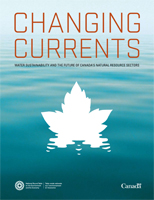News Release – June 17, 2010
NRTEE Releases New Report on Industrial Use of Canada’s Water by Natural Resource Sector
 June 17, 2010 – OTTAWA – The National Round Table on the Environment and the Economy today released a new report examining the sustainability of Canada’s water supply and its use by the nation’s major resource sectors.
June 17, 2010 – OTTAWA – The National Round Table on the Environment and the Economy today released a new report examining the sustainability of Canada’s water supply and its use by the nation’s major resource sectors.
The report, which reviews water use by the agriculture, forest, mining, electricity and oil and gas sectors, says that the time is now for Canadian policy makers, businesses, environmental groups and other concerned Canadians to look at ways to modernize outdated and inadequate water management practices. The report is entitled Changing Currents: Water Sustainability and the Future of Canada’s Natural Resource Sectors.
The report concludes:
- Data on precise water use and access to such data is limited, making it difficult to know the national supply of water and the amounts being used.
- Approaches to allocating water in most of Canada are increasingly outdated and may no longer be appropriate given new environmental pressures and competing economic interests.
- Several levels of governments share jurisdiction over monitoring and managing water, leading to potential confusion among businesses which need water for production purposes.
- There is an overall lack of capacity and expertise across the country to effectively manage water resources.
- The impacts of climate change are expected to transform the way Canadians need to manage water resources.
“Governance at a national level is not currently positioned to respond to expected increasing pressure on our water resources,” says the report’s executive summary. “This is largely due to jurisdictional complexity, inconsistent approaches across the country, policy fragmentation, a lack of resources, and insufficient technical, scientific, and policy capacity.”
Growth in the natural resource sectors is expected to climb by between 50 and 65 per cent by 2030. The report calls for a national framework to deal with the issues and expected pressures outlined in the report.
“While Canada is blessed with an abundance of freshwater, an expected increase in the development of the natural resource sectors begs the question of whether our country has enough to support economic growth while also maintaining the health of our ecosystems,” said NRTEE Vice-Chair Robert Slater.
NRTEE President and Chief Executive Officer David McLaughlin said Canada needs to get a better handle on the quantity of water being used and how much is needed in the future.
“New stresses and demands are likely to pose a significant challenge to the sustainability of Canada’s water resources if action is not taken now,” said Mr. McLaughlin.
The report was released on the day of the Canadian Water Summit in Mississauga, where Mr. McLaughlin took part.
In its next report, the Round Table will make policy recommendations to deal with water issues identified in the current volume. The report will focus on improving current water allocation approaches, better collection and management of water-use data, and new policy ideas for water management that include market-based instruments.
For more information or for interviews with David McLaughlin or Robert Slater, please contact:
Brian Laghi
NRTEE Director of Communications and Public Affairs
613-943-2054
613-882-8134 c
laghib@nrt-trn.ca
Report Highlights
- According to Statistics Canada, the natural resource sectors account for at least 84 per cent of gross water use in Canada. The figure does not include gross use by the hydro and oil and gas sectors.
- The natural resource sectors accounted for approximately 12.5 per cent of GDP in 2009 and are expected to grow by about 50-60 per cent by 2030.
- All Canadian provinces, with the exception of Prince Edward Island, share freshwater resources with other provinces/territories and/or the United States.
- At least 20 federal agencies have responsibilities regarding water management, covered under 11 different pieces of legislation.
- Water use licenses exist in all provinces and territories, but vary significantly from jurisdiction to jurisdiction. In most cases, one-time fees are payable at the time of application. Some provinces have fixed prices, while others have variable fees.
Sectoral Findings
- Thermal electric power generation is responsible for 64% of water withdrawn across Canada, making it the greatest water user in the country.
- In 2005, agriculture was responsible for 10% of gross water use and 66% of national consumption. Irrigation makes up 77 per cent of all agricultural water use.
- Unlike the thermal power sector, hydroelectric power is not a significant consumer of water. However, hydro facilities can affect stream flow and water levels and have important impacts on ecosystems and downstream users.
- The oil and gas sector uses relatively small volumes of water at the national level, but has important water quantity and quality impacts at the local level. In 2007, three-quarters of all Alberta’s oil production was water-assisted.
- British Columbia, Alberta and Saskatchewan together account for 92 per cent of agricultural water use in Canada.
- Mining operations can benefit from robust adaptive water management plans to cope with climate change. For example, melting permafrost in Canada’s North will have a serious impact on the stability of structures such as tailings impoundment facilities.
























